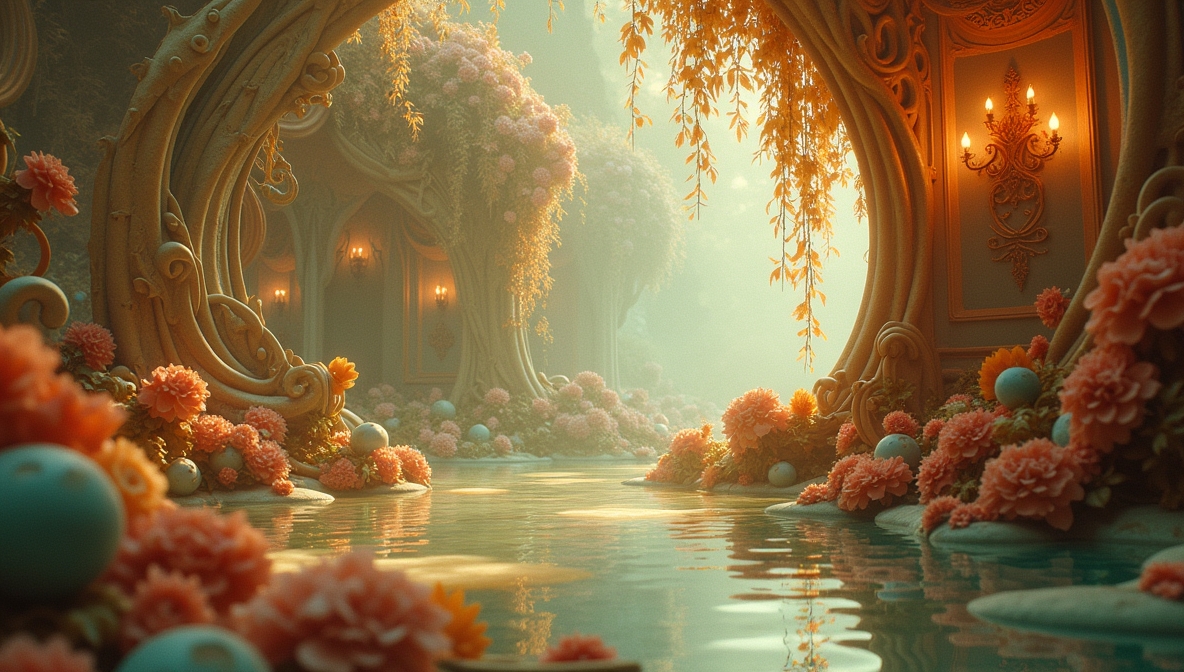Art Nouveau reshaped decorative arts with its fluid lines, organic motifs, and intricate craftsmanship. It blurred the boundaries between fine and applied arts, bringing artistry into everyday objects. This movement, spanning the late 19th and early 20th centuries, left a lasting imprint on architecture, furniture, textiles, ceramics, and glasswork.
Origins and Philosophy
Art Nouveau emerged as a response to industrialization, seeking to revive handcrafted artistry. It drew inspiration from nature, Japanese prints, and flowing forms. Artists rejected rigid historical styles in favor of curving lines and asymmetrical compositions. This movement was not confined to painting or sculpture—it transformed entire interiors, from door handles to wallpaper.
Characteristics in Decorative Arts
- Organic Forms – Inspired by flowers, vines, and insects, Art Nouveau featured fluid curves and sinuous lines.
- Asymmetry – Designs embraced irregularity, breaking from classical symmetry.
- Whiplash Motif – A signature element, characterized by dynamic, swirling lines.
- Exotic Influences – Japanese woodblock prints and Middle Eastern patterns influenced the aesthetic.
- Stylized Female Figures – Women with flowing hair often appeared in posters, ceramics, and textiles.
- Integration of Materials – Wood, glass, metal, and ceramics were combined harmoniously.
Impact on Various Decorative Arts
Architecture and Interiors
Art Nouveau architecture featured curved facades, ironwork, stained glass, and mosaic inlays. Interiors extended the same philosophy—every detail, from doorknobs to light fixtures, followed the flowing aesthetic.
Notable Examples:
- Antoni Gaudí’s Casa Batlló – Organic shapes, colorful mosaics, and sculpted stonework.
- Victor Horta’s Hôtel Tassel – Curving staircases and stained glass create a seamless interior.
- Hector Guimard’s Paris Métro Entrances – Ironwork with plant-like motifs blends nature with function.
Furniture Design
Craftsmen abandoned rigid, straight lines in favor of undulating curves and floral inlays. Wood, bronze, and glass merged to create functional art.
Defining Features:
- Carved wood mimicking vines and tendrils.
- Marquetry and inlaid materials adding depth.
- High-backed chairs with organic contours.
Key Figures:
- Émile Gallé – Marquetry furniture featuring botanical themes.
- Louis Majorelle – Elegant wooden pieces with sculpted metal details.
- Charles Rennie Mackintosh – Stylized geometric elements blended with organic forms.
Glass and Ceramics
Art Nouveau glasswork embraced iridescent finishes, layered colors, and intricate etchings. Ceramics mirrored these trends, with flowing designs and floral motifs.
Iconic Glass Artists:
- René Lalique – Delicate glassware with intricate relief designs.
- Émile Gallé – Multi-layered glass vases with nature-inspired etchings.
- Louis Comfort Tiffany – Stained glass windows, lamps, and decorative panels.
Ceramics Innovations:
- Massier Pottery – Iridescent glazes and organic textures.
- Zsolnay Porcelain – Eosin glaze created shimmering surfaces.
- Rozenburg Porcelain – Delicate, translucent floral designs.
Textiles and Wallpapers
Soft furnishings carried the same flowing motifs. Silk, velvet, and woven textiles featured vines, flowers, and peacock feathers. Wallpapers became elaborate, with nature-based prints and metallic accents.
Notable Designers:
- Arthur Heygate Mackmurdo – Early Art Nouveau textile patterns.
- William Morris – His organic designs laid the groundwork for the movement.
- Alphonse Mucha – Stylized prints featuring elegant female figures.
Jewelry and Metalwork
Goldsmiths and metalworkers embraced fluidity in brooches, necklaces, and hairpins. Jewelry featured sinuous lines, enamel work, and semi-precious stones.
Key Elements:
- Stylized dragonflies, orchids, and peacocks.
- Translucent enamel mimicking butterfly wings.
- Sculpted gold and silver creating flowing compositions.
Renowned Designers:
- René Lalique – Master of nature-inspired jewelry.
- Georges Fouquet – Known for bold Art Nouveau statement pieces.
- Henri Vever – Combined precious materials with intricate craftsmanship.
Legacy and Influence
Art Nouveau’s influence extended beyond its peak, shaping later movements like Art Deco and Mid-Century Modern. Its principles of craftsmanship and organic design continue to inspire contemporary artisans, proving that ornamentation and function can coexist beautifully.



